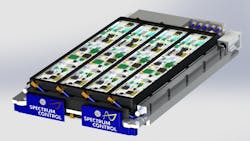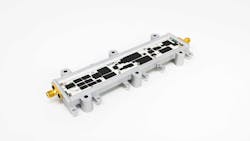Digitally Tunable Modular RF Blocks Empower Mil/Aero Systems
This article is part of the TechXchange: Defense Electronics.
When it comes to the size, weight, and performance requirements of advanced aerospace and defense systems, the best is barely good enough, as there's no second prize on the battlefield. Addressing these constantly growing demands, Spectrum Control recently introduced SCi Blocks (called “sky blocks”), a family of next-generation, digitally enabled, plug-and-play RF blocks.
These open, modular, and digitally enabled products are offered in three tiers: RF systems-in-packages (RFSiPs), RF “sticks,” and Sensor Open Systems Architecture (SOSA)-aligned OpenVPX modules. The ultra-miniature and high-performance wideband downconverters and upconverters provide the next level of SWaP-C for electronic warfare (EW), signal intelligence (SIGINT), and intelligence surveillance and reconnaissance (ISR) applications.
The company also unveiled an OpenVPX RF transceiver, which provides fidelity handling of RF signals with integral digital control and uses a minimal number of interconnects to expand design and usage options. Delivering total spectrum awareness from 20 MHz to 18 GHz, with up to 16 GHz of contiguous spectral coverage and 2 GHz of instantaneous bandwidth, the integrated digital gateway delivers a level of intelligence and connectivity previously unavailable in legacy RF components.
Using a simple four-wire interface for command and control along with health and temperature monitoring, the high-performance downconverter stick offers a gain of 25 dB and noise figure of 14 to 17 dB across the entire frequency range. Features include a 3rd-order intercept (IP3) of 25 dBm and single tone spurious of ≥60 dBc, along with IF calibration features for optimum spectral performance.
The upconverter stick provides a gain of 20 dB, with a noise figure of 25 dB across the frequency span, and an IP3 of 30 dBm, as well as a single tone spurious of ≥ –55 dBc at –10-dBm input and maximum gain. It offers independent user-controllable input and output gain control of 31.5 dB, in 0.5-dB increments. Provided in compact 13- x 2-cm packages drawing 8 and 10 W, respectively, both the downconverter and upconverter modules are available as a board-only solution or in a high-isolation, hermetically sealed, metal enclosure.
These wideband downconverter and upconverter sticks can be integrated into the SCi Block’s 3U eight-channel OpenVPX transceiver module in any combination, supporting up to eight downconverter or eight upconverter channels. Fully SOSA-aligned, the modules also have a Modular Open Radio Frequency Architecture (MORA) device layer for configuration and control, plus an RF interface compliant to VITA 67.3.
Read more articles in the TechXchange: Defense Electronics.
Related links:
About the Author
Alix Paultre
Editor-at-Large, Microwaves & RF
Alix is Editor-at-Large for Microwaves & RF.
An Army veteran, Alix Paultre was a signals intelligence soldier on the East/West German border in the early ‘80s, and eventually wound up helping launch and run a publication on consumer electronics for the U.S. military stationed in Europe. Alix first began in this industry in 1998 at Electronic Products magazine, and since then has worked for a variety of publications, most recently as Editor-in-Chief of Power Systems Design.
Alix currently lives in Wiesbaden, Germany.


